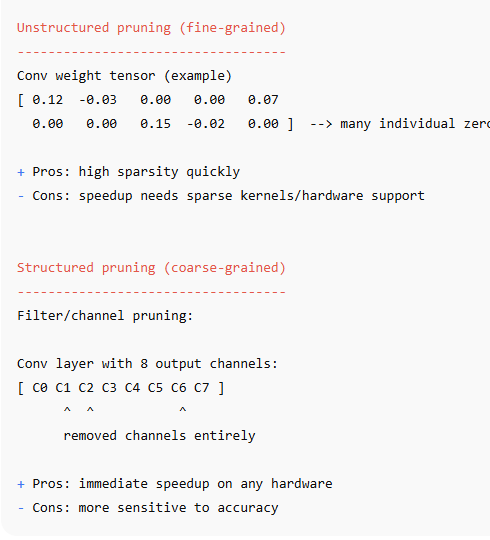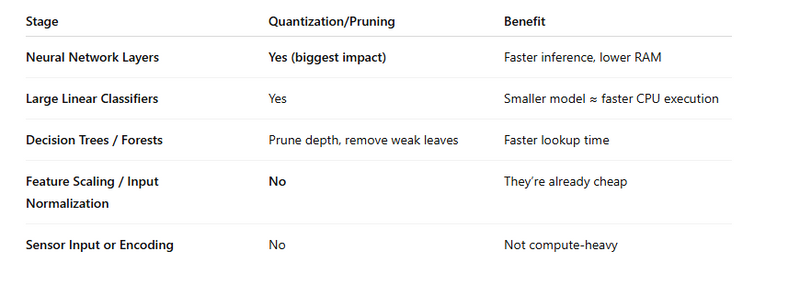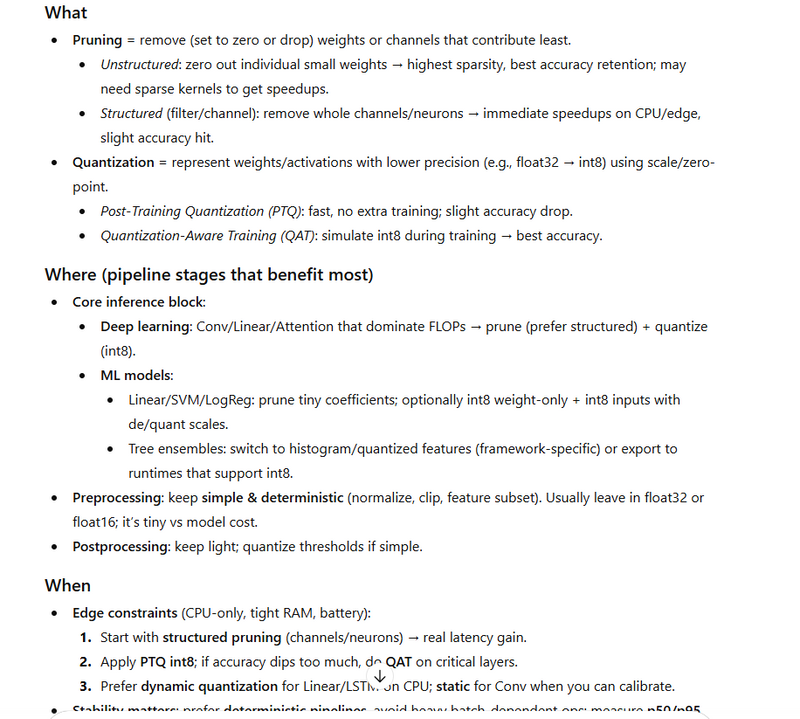Pruning
= delete (or zero-out) parts of a model that contribute little → fewer FLOPs, fewer parameters, faster inference.
Quantization
= store & compute with fewer bits (e.g., 8-bit instead of 32-bit floats) → smaller memory, higher cache hits, faster CPU ops.
Both aim to fit tight edge budgets (CPU-only, small RAM) while keeping accuracy good enough for real-time control.
Where they act in a network
Two flavors of pruning
Quantization pipeline (typical PTQ)
PTQ (Post-Training Quantization): No training required. Fastest path to int8.
QAT (Quantization-Aware Training): Train with fake-quant modules → better accuracy at int8, especially for CNNs.
Why robots care
Latency (ms-level) & consistency (low jitter) matter for control loops.
Size matters (RAM/flash budgets).
Robustness to noise: simpler models + calibrated quantization + structured pruning → fewer surprises.
Metrics to watch
Accuracy (task metric)
Latency (avg & p95/p99)
Model size (MB)
Sparsity (% zeros) & MACs/FLOPs
Energy (optional but relevant on battery)
ML EXAMPLES (scikit-learn)
We’ll show:
Decision Tree pruning (cost-complexity)
L1 “pruning” of linear/logistic models (drives coefficients to zero)
Note: Classic scikit-learn doesn’t do int8 quantization of models end-to-end; for edge you often export to ONNX + use runtimes that quantize, or you choose small models + pruning/L1.
1) Decision Tree – cost-complexity pruning
# ml_pruning_tree.py
import time
import numpy as np
from sklearn.datasets import load_iris
from sklearn.model_selection import train_test_split
from sklearn.tree import DecisionTreeClassifier
from sklearn.tree import plot_tree # optional (for visualization)
from sklearn.metrics import accuracy_score
X, y = load_iris(return_X_y=True)
Xtr, Xte, ytr, yte = train_test_split(X, y, test_size=0.2, random_state=42)
# Baseline (unpruned)
base = DecisionTreeClassifier(random_state=42)
base.fit(Xtr, ytr)
# Cost complexity pruning path gives candidate ccp_alphas
path = base.cost_complexity_pruning_path(Xtr, ytr)
ccp_alphas = path.ccp_alphas
best = None
best_stats = None
for ccp in ccp_alphas:
clf = DecisionTreeClassifier(random_state=42, ccp_alpha=ccp)
clf.fit(Xtr, ytr)
# measure latency per sample (simple timing)
t0 = time.time()
ypred = clf.predict(Xte)
t1 = time.time()
acc = accuracy_score(yte, ypred)
latency_ms = (t1 - t0) / len(Xte) * 1000.0
n_nodes = clf.tree_.node_count
stats = (acc, latency_ms, n_nodes, ccp)
if best is None or (acc > best_stats[0]) or (acc == best_stats[0] and latency_ms < best_stats[1]):
best, best_stats = clf, stats
print(f"Best pruned tree:")
print(f" accuracy = {best_stats[0]:.3f}")
print(f" latency = {best_stats[1]:.3f} ms/sample")
print(f" nodes = {best_stats[2]} (ccp_alpha={best_stats[3]:.6f})")
What this gives: a smaller tree → fewer branches → faster, more stable inference on CPU.
2) L1 “pruning” (sparse coefficients)
# ml_pruning_l1.py
import time
import numpy as np
from sklearn.datasets import load_iris
from sklearn.model_selection import train_test_split
from sklearn.linear_model import LogisticRegression
from sklearn.metrics import accuracy_score
X, y = load_iris(return_X_y=True)
Xtr, Xte, ytr, yte = train_test_split(X, y, test_size=0.2, random_state=42)
# L1 penalty drives many weights to zero (like pruning)
clf = LogisticRegression(penalty='l1', solver='saga', C=0.5, max_iter=500, multi_class='auto')
clf.fit(Xtr, ytr)
t0 = time.time()
yp = clf.predict(Xte)
t1 = time.time()
acc = accuracy_score(yte, yp)
latency_ms = (t1 - t0) / len(Xte) * 1000.0
sparsity = np.mean(clf.coef_ == 0.0)
print(f"Accuracy : {acc:.3f}")
print(f"Latency : {latency_ms:.3f} ms/sample")
print(f"Weight zeros : {sparsity*100:.1f}%")
Takeaway: Smaller effective feature set → cache-friendly, consistent latency.
DL EXAMPLES (PyTorch)
We’ll show:
Unstructured & structured pruning via torch.nn.utils.prune
Dynamic PTQ (int8) for Linear/LSTM
Static PTQ (FX graph mode) for a tiny CNN (with calibration)
QAT sketch for best accuracy at int8
These run on CPU and illustrate what to change. Replace synthetic data with your sensor features.
Helper: latency + size + sparsity utilities
# utils_perf.py
import time
import torch
import os
def measure_latency_ms(model, inp, n_warm=10, n_runs=50):
model.eval()
with torch.no_grad():
for _ in range(n_warm):
_ = model(inp)
t0 = time.time()
for _ in range(n_runs):
_ = model(inp)
t1 = time.time()
return (t1 - t0) / n_runs * 1000.0
def count_nonzero_params(model):
nz = 0
tot = 0
for p in model.parameters():
tot += p.numel()
nz += (p != 0).sum().item()
return nz, tot, 1.0 - nz / tot
def save_size_mb(model, path="temp.pth"):
torch.save(model.state_dict(), path)
sz = os.path.getsize(path) / (1024*1024)
os.remove(path)
return sz
A. PRUNING (PyTorch)
A1) Unstructured pruning (magnitude)
# dl_prune_unstructured.py
import torch
import torch.nn as nn
import torch.nn.utils.prune as prune
from utils_perf import measure_latency_ms, count_nonzero_params, save_size_mb
# Tiny MLP for demonstration
class MLP(nn.Module):
def __init__(self, d_in=64, d_hidden=128, d_out=10):
super().__init__()
self.net = nn.Sequential(
nn.Linear(d_in, d_hidden),
nn.ReLU(),
nn.Linear(d_hidden, d_out)
)
def forward(self, x):
return self.net(x)
model = MLP()
inp = torch.randn(1, 64)
lat0 = measure_latency_ms(model, inp)
nz0, tot0, sparsity0 = count_nonzero_params(model)
size0 = save_size_mb(model)
# Apply 80% unstructured pruning on Linear weights
for m in model.modules():
if isinstance(m, nn.Linear):
prune.l1_unstructured(m, name="weight", amount=0.8)
# Remove reparametrization (make pruning permanent)
for m in model.modules():
if isinstance(m, nn.Linear) and hasattr(m, "weight_orig"):
prune.remove(m, "weight")
lat1 = measure_latency_ms(model, inp)
nz1, tot1, sparsity1 = count_nonzero_params(model)
size1 = save_size_mb(model)
print(f"Latency (ms) before/after: {lat0:.3f} / {lat1:.3f}")
print(f"Sparsity before/after: {sparsity0*100:.1f}% / {sparsity1*100:.1f}%")
print(f"Model size (MB)before/after: {size0:.3f} / {size1:.3f}")
Note: Unstructured zeros may not speed up on vanilla kernels; you get memory benefits and speedups only if using sparse backends. For deterministic speed on CPU, prefer structured pruning.
A2) Structured channel pruning (conv channels)
# dl_prune_structured.py
import torch
import torch.nn as nn
import torch.nn.utils.prune as prune
from utils_perf import measure_latency_ms, count_nonzero_params, save_size_mb
class TinyCNN(nn.Module):
def __init__(self):
super().__init__()
self.conv1 = nn.Conv2d(3, 16, 3, padding=1)
self.relu = nn.ReLU()
self.conv2 = nn.Conv2d(16, 32, 3, padding=1)
self.pool = nn.AdaptiveAvgPool2d(1)
self.fc = nn.Linear(32, 10)
def forward(self, x):
x = self.relu(self.conv1(x))
x = self.relu(self.conv2(x))
x = self.pool(x).flatten(1)
return self.fc(x)
model = TinyCNN()
inp = torch.randn(1, 3, 64, 64)
lat0 = measure_latency_ms(model, inp)
nz0, tot0, s0 = count_nonzero_params(model)
size0 = save_size_mb(model)
# Prune entire output channels from conv2 (e.g., 50%)
# amount is fraction of channels to remove; dim=0 means output channels
prune.ln_structured(model.conv2, name="weight", amount=0.5, n=2, dim=0)
prune.remove(model.conv2, "weight")
lat1 = measure_latency_ms(model, inp)
nz1, tot1, s1 = count_nonzero_params(model)
size1 = save_size_mb(model)
print(f"Latency (ms) before/after: {lat0:.3f} / {lat1:.3f}")
print(f"Sparsity before/after: {s0*100:.1f}% / {s1*100:.1f}%")
print(f"Model size (MB)before/after: {size0:.3f} / {size1:.3f}")
Why structured helps: removed channels shrink subsequent ops → actual FLOP reduction and stable CPU speedups.
B. QUANTIZATION (PyTorch)
B1) Dynamic quantization (fastest path; great for Linear/LSTM on CPU)
# dl_quant_dynamic.py
import torch
import torch.nn as nn
from utils_perf import measure_latency_ms, save_size_mb
class TinyRNN(nn.Module):
def __init__(self, d_in=32, d_hidden=64, d_out=6):
super().__init__()
self.rnn = nn.LSTM(d_in, d_hidden, num_layers=1, batch_first=True)
self.fc = nn.Linear(d_hidden, d_out)
def forward(self, x):
# x: [B, T, d_in]
y, _ = self.rnn(x)
return self.fc(y[:, -1, :])
model_fp32 = TinyRNN().eval()
inp = torch.randn(1, 20, 32)
lat0 = measure_latency_ms(model_fp32, inp)
size0 = save_size_mb(model_fp32)
# Dynamic quantize only supported layer types (Linear, LSTM)
model_int8 = torch.ao.quantization.quantize_dynamic(
model_fp32, {nn.Linear, nn.LSTM}, dtype=torch.qint8
).eval()
lat1 = measure_latency_ms(model_int8, inp)
size1 = save_size_mb(model_int8)
print(f"Latency (ms) FP32 / INT8(dynamic): {lat0:.3f} / {lat1:.3f}")
print(f"Model size (MB)FP32 / INT8(dynamic): {size0:.3f} / {size1:.3f}")
Use when: CPU edge device, MLP/RNN control heads, quick wins without retraining.
B2) Static PTQ (FX graph mode) for a tiny CNN
# dl_quant_static_ptq.py
import torch
import torch.nn as nn
from torch.ao.quantization import get_default_qconfig_mapping
from torch.ao.quantization.quantize_fx import prepare_fx, convert_fx
from utils_perf import measure_latency_ms, save_size_mb
class TinyCNN(nn.Module):
def __init__(self):
super().__init__()
self.seq = nn.Sequential(
nn.Conv2d(3, 16, 3, stride=1, padding=1),
nn.ReLU(),
nn.Conv2d(16, 16, 3, stride=1, padding=1),
nn.ReLU(),
nn.AdaptiveAvgPool2d(1),
nn.Flatten(),
nn.Linear(16, 10)
)
def forward(self, x):
return self.seq(x)
model = TinyCNN().eval()
example = torch.randn(1, 3, 64, 64)
lat0 = measure_latency_ms(model, example)
size0 = save_size_mb(model)
# 1) Choose backend/qconfig
backend = "qnnpack" # good for ARM/Android; "fbgemm" for x86
torch.backends.quantized.engine = backend
qconfig_mapping = get_default_qconfig_mapping(backend)
# 2) Prepare FX graph
prepared = prepare_fx(model, {"": qconfig_mapping})
# 3) Calibrate with a small representative set
prepared(torch.randn(1,3,64,64))
prepared(torch.randn(1,3,64,64))
prepared(torch.randn(1,3,64,64))
# 4) Convert to int8
int8_model = convert_fx(prepared).eval()
lat1 = measure_latency_ms(int8_model, example)
size1 = save_size_mb(int8_model)
print(f"Latency (ms) FP32 / INT8(static): {lat0:.3f} / {lat1:.3f}")
print(f"Model size (MB)FP32 / INT8(static): {size0:.3f} / {size1:.3f}")
Calibrate carefully: use a few hundred real sensor samples for best accuracy.
B3) QAT sketch (best accuracy @ int8 for CNNs)
# dl_qat_skeleton.py
import torch
import torch.nn as nn
import torch.optim as optim
from torch.ao.quantization import get_default_qat_qconfig_mapping
from torch.ao.quantization.quantize_fx import prepare_qat_fx, convert_fx
class TinyCNN(nn.Module):
def __init__(self):
super().__init__()
self.seq = nn.Sequential(
nn.Conv2d(3, 16, 3, padding=1), nn.ReLU(),
nn.Conv2d(16,16,3,padding=1), nn.ReLU(),
nn.AdaptiveAvgPool2d(1), nn.Flatten(), nn.Linear(16, 10)
)
def forward(self, x): return self.seq(x)
model = TinyCNN().train()
backend = "qnnpack"
torch.backends.quantized.engine = backend
qconfig_mapping = get_default_qat_qconfig_mapping(backend)
# Insert fake-quant observers
model_qat = prepare_qat_fx(model, {"": qconfig_mapping}).train()
opt = optim.Adam(model_qat.parameters(), lr=1e-3)
# Train as usual (fake-quant active)
for step in range(200): # demo loop
x = torch.randn(16,3,64,64)
y = torch.randint(0,10,(16,))
logits = model_qat(x)
loss = nn.CrossEntropyLoss()(logits, y)
opt.zero_grad(); loss.backward(); opt.step()
# Convert to real int8
model_int8 = convert_fx(model_qat.eval()).eval()
Putting it together: which stages benefit most?
Perception & control networks (Conv/MLP/RNN heads) → Quantization (int8) + Structured pruning (channels) for real CPU gains.
Feature encoders (heavy backbones) → QAT (keep accuracy) + careful structured pruning of later blocks.
Classical ML pieces (trees, linear heads) → prune (cost-complexity / L1) and/or replace with smaller models; quantization usually handled by deployment runtime if needed.
Practical workflow (ASCII diagram)
Train FP32 ---> Profile (lat/size/acc) ---> Choose targets
\
\--> Structured prune (channels/heads) -> Fine-tune
-> PTQ (dynamic/static) or QAT
-> Re-profile (p50/p95 latency, acc, size)
-> Iterate until SLA met
Which Stages Benefit Most from Quantization or Pruning?
Best Stage to Apply Quantization/Pruning
The Model / Inference Stage
This is where matrix multiplications and decision logic happen.
❌ Not Useful to Quantize/Prune
So:
The parts that benefit the most are:
Neural network layers (Linear, Conv, GRU/LSTM)
Decision trees / Random Forests (by pruning depth or removing weak nodes)
Large linear models (by pruning small-magnitude weights)
Part 1: Classical ML Example
We will:
Train Logistic Regression
Prune small weights
Quantize model weights to float16 to reduce memory + improve speed
# ===== classical_prune_quant.py =====
import numpy as np
from sklearn.datasets import load_iris
from sklearn.preprocessing import StandardScaler
from sklearn.linear_model import LogisticRegression
from sklearn.pipeline import Pipeline
from sklearn.metrics import accuracy_score
# Load dataset
data = load_iris()
X, y = data.data, data.target
# Build pipeline
pipe = Pipeline([
("scaler", StandardScaler()),
("clf", LogisticRegression(max_iter=500, multi_class='multinomial'))
])
pipe.fit(X, y)
clf = pipe.named_steps["clf"]
print("Original weights shape:", clf.coef_.shape)
# ----- PRUNING: remove small weights -----
threshold = np.percentile(np.abs(clf.coef_), 20) # prune 20% smallest weights
mask = np.abs(clf.coef_) > threshold
clf.coef_ = clf.coef_ * mask
print("Pruned weights mean magnitude:", np.mean(np.abs(clf.coef_)))
# ----- QUANTIZATION: convert to float16 -----
clf.coef_ = clf.coef_.astype(np.float16)
clf.intercept_ = clf.intercept_.astype(np.float16)
print("After quantization dtype:", clf.coef_.dtype)
# Check accuracy
y_pred = pipe.predict(X)
print("Accuracy after prune + quant:", accuracy_score(y, y_pred))
Result:
Model is lighter, smaller, and usually faster on edge CPUs.
Accuracy remains similar (because small weights typically don’t matter).
✅
Part 2: Deep Learning Example (PyTorch)
We will:
Train a tiny MLP
Prune weights with torch.nn.utils.prune
Quantize using PyTorch dynamic quantization
Compare latency
# ===== dl_prune_quant.py =====
import torch
import torch.nn as nn
import torch.nn.utils.prune as prune
import time
import numpy as np
# Create dummy dataset
X = torch.randn(300, 16)
y = torch.randint(0, 3, (300,))
# Tiny MLP model
class MLP(nn.Module):
def __init__(self):
super().__init__()
self.fc1 = nn.Linear(16, 32)
self.fc2 = nn.Linear(32, 3)
def forward(self, x):
return self.fc2(torch.relu(self.fc1(x)))
model = MLP()
criterion = nn.CrossEntropyLoss()
optimizer = torch.optim.Adam(model.parameters(), lr=1e-2)
# Train briefly
for _ in range(200):
optimizer.zero_grad()
loss = criterion(model(X), y)
loss.backward()
optimizer.step()
# -------- PRUNING --------
prune.l1_unstructured(model.fc1, name="weight", amount=0.3) # prune 30% of weights
prune.remove(model.fc1, 'weight') # finalize mask
# -------- QUANTIZATION --------
quantized_model = torch.quantization.quantize_dynamic(
model, {nn.Linear}, dtype=torch.qint8
)
# -------- LATENCY TEST --------
def bench(model):
model.eval()
times=[]
for _ in range(500):
inp = torch.randn(1,16)
t0=time.time()
_=model(inp)
times.append((time.time()-t0)*1000)
return np.mean(times), np.percentile(times,95)
fp32_mean, fp32_p95 = bench(model)
int8_mean, int8_p95 = bench(quantized_model)
print("FP32 latency avg:", fp32_mean, "ms p95:", fp32_p95)
print("INT8 latency avg:", int8_mean, "ms p95:", int8_p95)







Top comments (0)